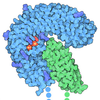+ Open data
Open data
- Basic information
Basic information
| Entry | Database: PDB / ID: 4v2c | ||||||
|---|---|---|---|---|---|---|---|
| Title | mouse FLRT2 LRR domain in complex with rat Unc5D Ig1 domain | ||||||
 Components Components |
| ||||||
 Keywords Keywords | APOPTOSIS / UNC5 / UNCOORDINATED-5 / LEUCINE-RICH REPEAT | ||||||
| Function / homology |  Function and homology information Function and homology informationcell adhesion involved in heart morphogenesis / Downstream signaling of activated FGFR1 / netrin receptor activity / : / basement membrane organization / fibroblast growth factor receptor binding / chemorepellent activity / regulation of neuron migration / pyramidal neuron differentiation / positive regulation of synapse assembly ...cell adhesion involved in heart morphogenesis / Downstream signaling of activated FGFR1 / netrin receptor activity / : / basement membrane organization / fibroblast growth factor receptor binding / chemorepellent activity / regulation of neuron migration / pyramidal neuron differentiation / positive regulation of synapse assembly / fibroblast growth factor receptor signaling pathway / heart morphogenesis / axon guidance / cell-cell junction / presynaptic membrane / postsynaptic membrane / neuron projection / focal adhesion / apoptotic process / endoplasmic reticulum membrane / glutamatergic synapse / cell surface / extracellular space / plasma membrane Similarity search - Function | ||||||
| Biological species |   | ||||||
| Method |  X-RAY DIFFRACTION / X-RAY DIFFRACTION /  SYNCHROTRON / SYNCHROTRON /  MOLECULAR REPLACEMENT / Resolution: 4 Å MOLECULAR REPLACEMENT / Resolution: 4 Å | ||||||
 Authors Authors | Seiradake, E. / del Toro, D. / Nagel, D. / Cop, F. / Haertl, R. / Ruff, T. / Seyit-Bremer, G. / Harlos, K. / Border, E.C. / Acker-Palmer, A. ...Seiradake, E. / del Toro, D. / Nagel, D. / Cop, F. / Haertl, R. / Ruff, T. / Seyit-Bremer, G. / Harlos, K. / Border, E.C. / Acker-Palmer, A. / Jones, E.Y. / Klein, R. | ||||||
 Citation Citation |  Journal: Neuron / Year: 2014 Journal: Neuron / Year: 2014Title: Flrt Structure: Balancing Repulsion and Cell Adhesion in Cortical and Vascular Development Authors: Seiradake, E. / Del Toro, D. / Nagel, D. / Cop, F. / Haertl, R. / Ruff, T. / Seyit-Bremer, G. / Harlos, K. / Border, E.C. / Acker-Palmer, A. / Jones, E.Y. / Klein, R. | ||||||
| History |
|
- Structure visualization
Structure visualization
| Structure viewer | Molecule:  Molmil Molmil Jmol/JSmol Jmol/JSmol |
|---|
- Downloads & links
Downloads & links
- Download
Download
| PDBx/mmCIF format |  4v2c.cif.gz 4v2c.cif.gz | 361.1 KB | Display |  PDBx/mmCIF format PDBx/mmCIF format |
|---|---|---|---|---|
| PDB format |  pdb4v2c.ent.gz pdb4v2c.ent.gz | 300.6 KB | Display |  PDB format PDB format |
| PDBx/mmJSON format |  4v2c.json.gz 4v2c.json.gz | Tree view |  PDBx/mmJSON format PDBx/mmJSON format | |
| Others |  Other downloads Other downloads |
-Validation report
| Arichive directory |  https://data.pdbj.org/pub/pdb/validation_reports/v2/4v2c https://data.pdbj.org/pub/pdb/validation_reports/v2/4v2c ftp://data.pdbj.org/pub/pdb/validation_reports/v2/4v2c ftp://data.pdbj.org/pub/pdb/validation_reports/v2/4v2c | HTTPS FTP |
|---|
-Related structure data
| Related structure data | 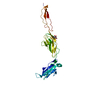 4v2aC 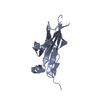 4v2bSC  4v2dC  4v2eC C: citing same article ( S: Starting model for refinement |
|---|---|
| Similar structure data |
- Links
Links
- Assembly
Assembly
| Deposited unit | 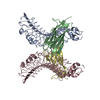
| ||||||||
|---|---|---|---|---|---|---|---|---|---|
| 1 | 
| ||||||||
| 2 | 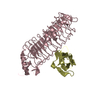
| ||||||||
| Unit cell |
|
- Components
Components
| #1: Protein | Mass: 37037.426 Da / Num. of mol.: 2 / Fragment: LRR DOMAIN, RESIDUES 35-362 Source method: isolated from a genetically manipulated source Source: (gene. exp.)   HOMO SAPIENS (human) / References: UniProt: Q8BLU0 HOMO SAPIENS (human) / References: UniProt: Q8BLU0#2: Protein | Mass: 18128.379 Da / Num. of mol.: 2 / Fragment: IG1 DOMAIN, RESIDUES 1-161 Source method: isolated from a genetically manipulated source Source: (gene. exp.)   HOMO SAPIENS (human) / References: UniProt: F1LW30 HOMO SAPIENS (human) / References: UniProt: F1LW30Has protein modification | Y | Sequence details | N-TERMINUS IS CLEAVED DURING EXPRESSION. CONTAINS C- TERMINAL HIS TAG. N-TERMINUS IS CLEAVED. C- ...N-TERMINUS IS CLEAVED DURING EXPRESSION | |
|---|
-Experimental details
-Experiment
| Experiment | Method:  X-RAY DIFFRACTION X-RAY DIFFRACTION |
|---|
- Sample preparation
Sample preparation
| Crystal | Density Matthews: 4.04 Å3/Da / Density % sol: 69.54 % / Description: NONE |
|---|
-Data collection
| Diffraction | Mean temperature: 100 K |
|---|---|
| Diffraction source | Source:  SYNCHROTRON / Site: SYNCHROTRON / Site:  Diamond Diamond  / Beamline: I04-1 / Wavelength: 0.92 / Beamline: I04-1 / Wavelength: 0.92 |
| Detector | Type: DECTRIS PILATUS 2M / Detector: PIXEL |
| Radiation | Protocol: SINGLE WAVELENGTH / Monochromatic (M) / Laue (L): M / Scattering type: x-ray |
| Radiation wavelength | Wavelength: 0.92 Å / Relative weight: 1 |
| Reflection | Resolution: 4→87 Å / Num. obs: 102048 / % possible obs: 98.8 % / Redundancy: 6.9 % / Biso Wilson estimate: 136.77 Å2 / Rmerge(I) obs: 0.17 / Net I/σ(I): 8.4 |
| Reflection shell | Resolution: 4→4.1 Å / Redundancy: 5.9 % / Mean I/σ(I) obs: 0.87 / % possible all: 87.8 |
- Processing
Processing
| Software |
| |||||||||||||||||||||||||||||||||||||||||||||||||||||||||||||||||||||||||||||||||||||||||||||||||||||||||||||||||||||||||||||
|---|---|---|---|---|---|---|---|---|---|---|---|---|---|---|---|---|---|---|---|---|---|---|---|---|---|---|---|---|---|---|---|---|---|---|---|---|---|---|---|---|---|---|---|---|---|---|---|---|---|---|---|---|---|---|---|---|---|---|---|---|---|---|---|---|---|---|---|---|---|---|---|---|---|---|---|---|---|---|---|---|---|---|---|---|---|---|---|---|---|---|---|---|---|---|---|---|---|---|---|---|---|---|---|---|---|---|---|---|---|---|---|---|---|---|---|---|---|---|---|---|---|---|---|---|---|---|
| Refinement | Method to determine structure:  MOLECULAR REPLACEMENT MOLECULAR REPLACEMENTStarting model: PDB ENTRY 4V2B Resolution: 4→87.84 Å / Cor.coef. Fo:Fc: 0.6709 / Cor.coef. Fo:Fc free: 0.6392 / Cross valid method: THROUGHOUT / σ(F): 0 / SU Rfree Blow DPI: 0.877 Details: IDEAL-DIST CONTACT TERM CONTACT SETUP. ALL ATOMS HAVE CCP4 ATOM TYPE FROM LIBRARY
| |||||||||||||||||||||||||||||||||||||||||||||||||||||||||||||||||||||||||||||||||||||||||||||||||||||||||||||||||||||||||||||
| Displacement parameters | Biso mean: 111.61 Å2
| |||||||||||||||||||||||||||||||||||||||||||||||||||||||||||||||||||||||||||||||||||||||||||||||||||||||||||||||||||||||||||||
| Refine analyze | Luzzati coordinate error obs: 1.593 Å | |||||||||||||||||||||||||||||||||||||||||||||||||||||||||||||||||||||||||||||||||||||||||||||||||||||||||||||||||||||||||||||
| Refinement step | Cycle: LAST / Resolution: 4→87.84 Å
| |||||||||||||||||||||||||||||||||||||||||||||||||||||||||||||||||||||||||||||||||||||||||||||||||||||||||||||||||||||||||||||
| Refine LS restraints |
| |||||||||||||||||||||||||||||||||||||||||||||||||||||||||||||||||||||||||||||||||||||||||||||||||||||||||||||||||||||||||||||
| LS refinement shell | Resolution: 4→4.32 Å / Total num. of bins used: 7
| |||||||||||||||||||||||||||||||||||||||||||||||||||||||||||||||||||||||||||||||||||||||||||||||||||||||||||||||||||||||||||||
| Refinement TLS params. | Method: refined / Refine-ID: X-RAY DIFFRACTION
| |||||||||||||||||||||||||||||||||||||||||||||||||||||||||||||||||||||||||||||||||||||||||||||||||||||||||||||||||||||||||||||
| Refinement TLS group |
|
 Movie
Movie Controller
Controller



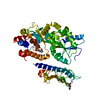


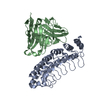


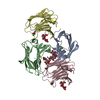


 PDBj
PDBj
